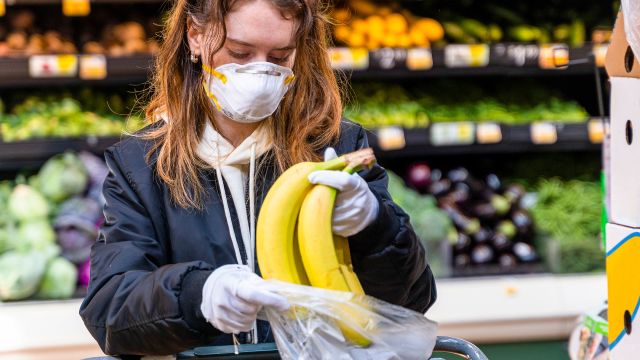Updated on April 10, 2020.
In recent weeks, empty store shelves across the country have created an impression of food and other product shortages. But experts say that the issue isn’t about supply, but rather demand: Millions of people are trying to stock up all at the same time.
Sometimes, the need to stock up for emergencies can be anticipated. For example, residents of Southeastern states routinely store supplies ahead of hurricane season in the summer and fall. In addition, most disasters are regional so emergency responders can shift extra resources to hard-hit areas. But the COVID-19 crisis is nationwide, which means resource-shifting won’t work.
Another issue? U.S. supermarkets and department stores operate on a “just-in-time” system. Rather than keeping large amounts of stock on hand, stores get goods delivered as needed. During normal times, this reduces labor and storage costs and can lessen waste. Lately, however, stores haven’t been able to keep up with the surge in demand—and those empty shelves encourage panic-buying.
“You go in, you see that there’s not much left, so you grab extra. This perceived shortage creates an actual shortage,” says Jeff Schlegelmilch, deputy director of the National Center for Disaster Preparedness at Columbia University in New York City.
Fortunately, a handful of simple tactics can help you meet your household’s basic needs without reducing your quality of life or going broke. Here’s how to stay safe and stocked.
Know what to have on hand
Our basic needs are food, water, shelter and sanitation. Depending on your situation, you might also add medication, baby products or pet supplies to the list.
During the pandemic, it’s a good idea for most people to have a few extra supplies available to meet their basic needs. Try to stock enough groceries for at least a week—or two weeks if you can—and have a 90-day supply of medication in-house. The Centers for Disease Control and Prevention recommends that high-risk groups, which include seniors and people with chronic medical conditions like heart disease and diabetes, have at least several weeks’ worth of food, household supplies and medication.
Sanitation is of particular urgency with COVID-19. It can be hard to find bleach or antiseptic sprays and wipes. Unlike some emergencies, however, the pandemic isn’t expected to cause a loss of infrastructure or utilities. People can still get water to wash their hands and clean their immediate environments, and most goods can still be transported—even if some of them, like bleach and soap, are hard to find.
Shop smart
To help slow the spread of disease, you should follow any stay at home orders in your area and not shop unless it’s absolutely necessary. When you do go out, limit the number the stores you visit and make sure to follow mask and social distancing guidelines.
Once you’re at a store, if you can’t find what you want, ask when restocking is expected and come back then. Another tactic: Visit more than one store, since Supermarket B might have what Supermarket A doesn’t. Again, remember to keep your store visits to a minimum.
Remember to investigate food options throughout supermarket aisles. The Asian or Latino food sections might still have dry beans and rice, along with sauces and spices to make plain fare taste better.
Check the health food aisle, too. If boxed macaroni and cheese is sold out in its regular shelf location, for example, an organic version may still be available there. It’ll probably cost a little more but can feed several people at once, especially if you add a little extra macaroni. The organic department may also have nut butters, beans, nuts and dried fruit. Since some supermarkets now limit meat purchases, look for high-protein products like quinoa and lentils, as well.
Branch out a little
When you have to shop, you may want to consider an option outside your normal supermarket, such as:
- International grocers. Asian supermarkets, Mexican shops and other “ethnic” markets often have good prices on staples like rice, beans and produce. Many also carry typical supermarket fare.
- Restaurant supply stores. Some are open to the public and sell not just canned, fresh and frozen foods, but also paper products and bleach. Split an order with friends—unless you really can eat 25 pounds of carrots before they sprout.
- Dollar stores. Paper products, bleach, wipes and a surprising number of food items can be found here. Some discount chains also carry refrigerated and frozen foods and fresh produce, along with fancier items like kalamata olives and pickled Italian vegetables.
- Bakery outlets. In addition to sandwich bread, these stores often sell tortillas, bagels, wraps, English muffins, rolls and pastries. Some feature non-bread products as well, from coffee to canned sardines to frozen spareribs.
- “Pop-up” groceries. Restaurants in places like Los Angeles, Austin and Palm Beach County are selling basic foodstuffs along with to-go meals. Some areas have pop-up pantries sponsored by food banks or individual citizens, as well. Find them by searching online for “pop-up grocery/pantry near me.”
- Food bank. Depending on your finances and the size of your family, you might qualify. Look for ones in your area at FeedingAmerica.org.
- Online merchants. Anyone who’s checked the Amazon, Walmart or Target websites lately has seen the words “out of stock.” So, play the long game, Schlegelmilch says: “Order now, knowing there might be a delay,” and use what you have in the meantime.
You can also try online shopping at janitorial supply companies, office-supply stores and home-improvement centers. You might get back-ordered—but you might luck out.
Get creative and be open to substitutions
Suppose you’re big on animal protein but fresh meat supplies are limited. Canned chicken, turkey, tuna or salmon are decent substitutes and are fine for sandwiches, casseroles and soups. Tofu, eggs, plant-based meat substitutes or high-protein grains can also fill you up when you’re running low on meat. You can stretch eggs with a carton of liquid whites or egg substitutes.
Maybe you tend to eat lots of pasta, grains and cheese—but are having a hard time finding those products or coming up with creative ways to cook them. Type your available ingredients into a search engine plus the phrase “easy recipes.” You’ll be amazed at what pops up.
Need more ideas? The U.S. Department of Agriculture maintains multiple databases for simple, healthy recipes made with relatively few ingredients. Try Healthy Eating on a Budget or SNAP Recipes to start.
Avoid panic-buying
Wherever you shop and whatever you purchase, resist the impulse to overbuy.
“There’s no need to panic or to hoard. That just stresses the supply chain,” says Steven J. Jensen, PhD, a member of the American Red Cross Scientific Advisory Council.
His approach: “Making sure we have enough food without taking more than our share.” If a jar of peanut butter lasts you a month, why are there 10 in your cart?
Jensen also suggests learning to “do the best we can with what’s in front of us” both now and in the future.
“It’s going to be months before you can walk into the supermarket and have 12 different kinds of ketchup available,” Jensen says, “But that’s okay.”






